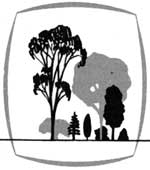|
NATIONAL PARK SERVICE Forests and Trees of the National Park System |
 |
Introduction

WITH THE PROGRESSIVE REDUCTION and disappearance of the natural and undisturbed forests of the United States through lumbering and forest fires, the primeval stands preserved within the national parks and monuments become of greater value and importance. By wise provision of Congress, the forests of the National Park System are withdrawn from commercial exploitation. The act of August 25, 1916, establishing the National Park Service, enjoins the Service "to conserve the scenery and the natural and historic objects and the wildlife therein and to provide for the enjoyment of the same in such manner and by such means as will leave them unimpaired for the enjoyment of future generations."
The forests of the National Park System form a magnificent framework to the mountains, lakes, streams, and other geological features of the parks and monuments, adding immeasurably to their inspirational appeal. Likewise, the recreational values of these areas are enhanced mightily by the presence of trees. It would be difficult to imagine the present popularity of camping and travel within the national parks and monuments should they by any misfortune be denuded of their forests or tree growth. What are now our most attractive campgrounds would be abandoned; even at timberline the loss of the gnarled, windswept trees battling for existence would remove one of the prized features of high mountain scenery.
The forested lands at the higher elevations within the National Park System are located within the "protection forest" belt, so called because their chief value is watershed protection, including the regulation of streamflow and prevention of erosion and avalanches. In addition to those values, these forests are important as wildlife habitat and for recreation and scenery.
In a number of instances the national parks include, at the lower elevations, portions of forests of high commercial value, as for example in Great Smoky Mountains, Yosemite, Sequoia, and Olympic National Parks. An aroused and insistent public urged the preservation of these forested areas, and the question was carefully weighed by Congress before these areas were set aside as national parks or parts thereof. In the East, several of the States have participated in the purchase of private forested lands for inclusion in national parks within State boundaries. The Rockefeller philanthropies have likewise assisted in such acquisition for national park purposes both in the East and in the West. As the remnants of our original forest disappear under the axe or become modified by commercial enterprise, these natural areas will become increasingly important for the study and enjoyment of Nature in its undisturbed state.
It is estimated that when the first colonies were established in America, forests occupied 937 million acres of the land now included in the 48 States of this Nation. Over this area, virgin forests have been reduced to approximately 5.4 percent of their original extent, now represented in large part in the National Park System, in the less accessible areas of the national forests, and in State parks and preserves. Of the total area of 22,278,502 acres in the National Park System (as of June 30, 1952), 8,109,945 acres are forested; 7,482,069 acres of this forest land are located within the 48 States. This is approximately 1.2 percent of the present forested area of 622 million acres in the continental United States.

|

|
| NPS History | History & Culture | National Park Service | Contact |
|
Last Modified: Fri, Feb 9 2007 10:00:00 pm PST |


